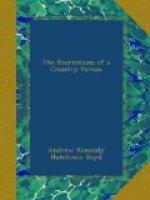There are one or two extreme cases in which it is in good taste, and the effect not without sublimity, to leave a monument with no inscription at all. Of course this can only be when the monument is that of a very great and illustrious man. The pillar erected by Bernadotte at Frederickshall, in memory of Charles the Twelfth, bears not a word; and I believe most people who visit the spot feel that Bernadotte judged well. The rude mass of masonry, standing in the solitary waste, that marks where Howard the philanthropist sleeps, is likewise nameless. And when John Kyrle died in 1724, he was buried in the chancel of the church of Ross in Herefordshire, ‘without so much as an inscription.’ But the Man of Ross had his best monument in the lifted head and beaming eye of those he left behind him at the mention of his name. He never knew, of course, that the bitter little satirist of Twickenham would melt into unwonted tenderness in telling of all he did, and apologize nobly for his nameless grave:—
And what! no monument, inscription,
stone?
His race, his form, his name
almost, unknown?
Who builds a church to God,
and not to fame,
Will never mark the marble
with his name:
Go, search it there, where
to be born and die,
Of rich and poor make all
the history:
Enough, that virtue filled
the space between,
Proved, by the ends of being,
to have been!
[Footnote: Pope’s Moral Essays. Epistle iii.]
The two fine epitaphs written by Ben Jonson are well known. One is on the Countess of Pembroke:—
Underneath this marble hearse,
Lies the subject of all verse:
Sidney’s sister, Pembroke’s’mother;
Death! ere thou hast slain
another,
Learned and fair, and good
as she,
Time shall throw a dart at
thee.
And the other is the epitaph of a certain unknown Elizabeth:—
Wouldst thou hear what man
can say
In a little?—reader,
stay.
Underneath this stone doth
lie
As much beauty as could die;
Which in life did harbour
give,
To more virtue than doth live.
If at all she had a fault,
Leave it buried in this vault:
One name was Elizabeth,
The other let it sleep with
death:
Fitter, where it died, to
tell,
Than that it lived at all.
Farewell!
Most people have heard of the brief epitaph inscribed on a tombstone in the floor of Hereford Cathedral, which inspired one of the sonnets of Wordsworth. There is no name, no date, but the single word MISERRIMUS. The lines, written by herself, which are inscribed on the gravestone of Mrs. Hemans, in St. Anne’s Church at Dublin, are very beautiful, but too well known to need quotation. And Longfellow, in his charming little poem of Nuremburg, has preserved the characteristic word in the epitaph of Albert Durer:—
Emigravit is the inscription
on the tombstone where he lies;
Dead he is not,—but
departed,—for the artist never dies.




